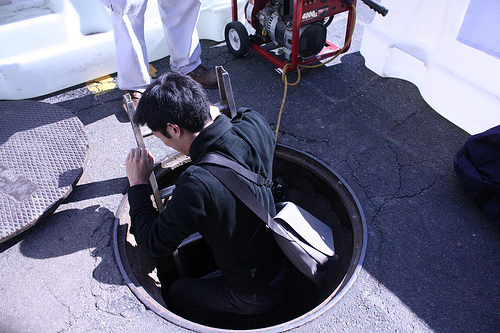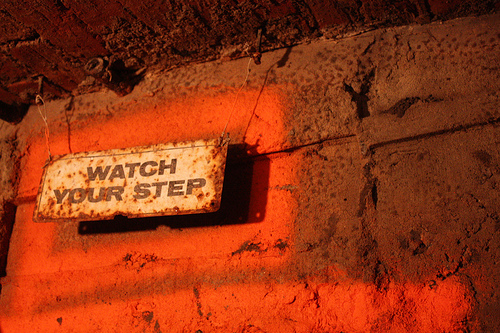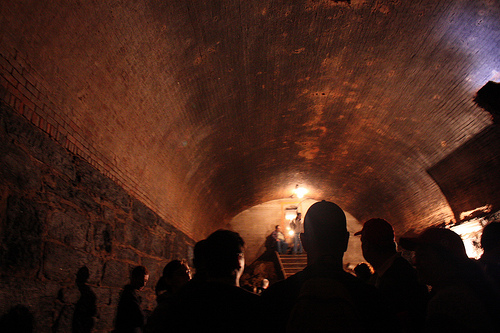Underground
Location | Underground, Brooklyn
We’re underground and I wanted to get a few facts in here. [I started this post earlier today.] So while on the tour I typed away furiously the facts that our guide, Bob Diamond (the one who discovered the tunnel again) spoke about. So here is the story of the Atlantic Avenue Tunnel with many stories as told by Bob Diamond (and their supporting evidence). So underneath Atlantic Avenue in Cobble Hill, Brooklyn, lays a tunnel approximately half a mile long. Opened in 1844, closed in 1861.
Bob Diamond and others give tours of the tunnel twice a month, and as part of the Open House New York Weekend, I was able to secure 2 spots on the tour along with 120ish others. The tour begins at the corner of Atlantic Avenue and Court Street next to the Brooklyn Trader Joe’s. A line snakes against the sidewalk. You can only enter the tunnel 20 at at time since the entrance to the tunnel is actually a manhole in the middle of the intersection. In groups we cross halfway to a cordoned off portion of the street and wait our turn to climb down a (short) ladder about 6-7 feet in the ground.
Then it’s a careful maneuvering as you walk across a short plank, under a large beam wrapped in bright yellow caution tape and then through a small-human sized hole in a cement wall labeled “WATCH YOUR STEP.” On the other side of the hole is a wooden staircase that leads you into the very humid subway tunnel.
The Atlantic Avenue Tunnel is considered the oldest subway tunnel in the world. It was built in 1844 by Cornelius Vanderbilt because Brooklynites (pedestrians and wagons alike) were getting run over by the train system that ran along Atlantic Avenue (since apparently the trains had no brakes and came barreling out of the then-forest without warning.) Too bad, according to Bob Diamond, Vanderbilt didn’t build the tunnel to save lives, but to save time in when they had to clean up the streets of carriage and pedestrian carnage.
Anyway, so the railway, and then tunnel, were built because during that time they needed a way to get shipments from the New York Harbor to Boston via train. The tunnel began construction in May of 1844 and they were given 4 months to complete construction. Of course, it wasn’t completed until December 1844 (well opened, according to Wiki, fully completed in 1845). During this time, because Brooklyn and the rest of Long Island is actually a pile of soil due to debris left by glaciers that had traveled across the North American landmass, it is impossible to dig a tunnel. So they used the “cut and cover” method, where you dig a trench, roof over the area then cover again.
To try to meet the deadline of 4 months, apparently they hired an overseer who is a cross between a construction foreman and a slave driver to make the (mostly Irish) sandhogs (those digging and making 13 cents a day) work everyday of the week (yes, including Sunday, the Sabbath). The workers did not take too kindly to this and apparently they shot and killed the overseer, chopped up his body and buried it in the walls of the tunnel.
Love it. So much fun history in this tunnel.
So fast forward, the tunnel closed in 1961 due to Lynchfield Brothers who wanted the LIRR to leave Brooklyn. After a controversial ruling that banned underground trains, the tunnel shut down in 1961. The tunnel was to be filled in, but in reality the man hired (strangely enough, a Lynchfield) only sealed off the ends, filled in some space with dirt and the tunnel lay forgotten (although appearing occasionally in random news articles) until 1979 when then-19 year old Bob Diamond went looking for the tunnel.
Luckily, despite being discouraged, he found the tunnel and now tours are given and he is trying to preserve the history with the Brooklyn Historic Railway Association.
There’s a lot more history to the tunnel, but you can go hear about it on the tour (or check out the BHRA’s website).
You can also read more details at:


